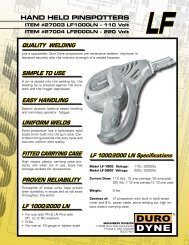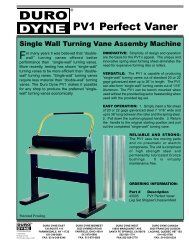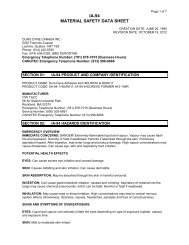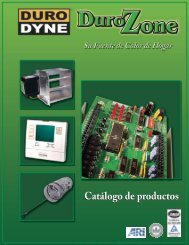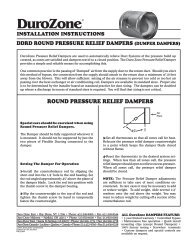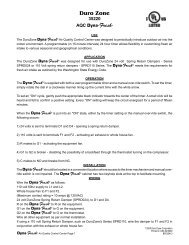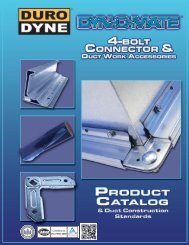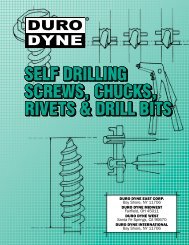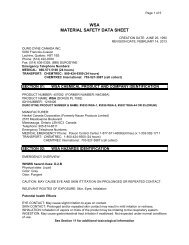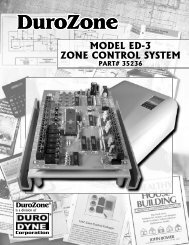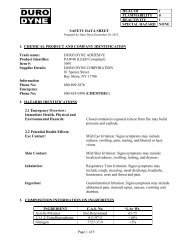MATERIAL SAFETY DATA SHEET Prepared by Duro Dyne ...
MATERIAL SAFETY DATA SHEET Prepared by Duro Dyne ...
MATERIAL SAFETY DATA SHEET Prepared by Duro Dyne ...
You also want an ePaper? Increase the reach of your titles
YUMPU automatically turns print PDFs into web optimized ePapers that Google loves.
<strong>MATERIAL</strong> <strong>SAFETY</strong> <strong>DATA</strong> <strong>SHEET</strong><br />
<strong>Prepared</strong> <strong>by</strong> <strong>Duro</strong> <strong>Dyne</strong> September 30, 2009<br />
1. CHEMICAL PRODUCT AND COMPANY IDENTIFICATION<br />
Trade name:<br />
Supplier Detail:<br />
Information<br />
Phone No: 800-899-3876<br />
Emergency<br />
Phone No:<br />
FT-2 DUCT SEALER MEMBRANE TAPE<br />
DURO DYNE CORPORATION<br />
81 Spence Street<br />
Bay Shore, NY 11706<br />
800-424-9300 (CHEMTREC)<br />
2. COMPOSITION / INFORMATION ON INGREDIENTS<br />
Principal Hazardous Components: Fibrous Glass Fibrous Glass Dust<br />
(Textile Grade)<br />
CAS #: N/A N/A<br />
Weight %: 92.0% N/A<br />
Flash Point Degree ºF: N/A N/A<br />
OSHA PEL: N/A 5 mg/m3 (Respirable)<br />
ACGIH TLV: N/A 5 mg/m3 (Inhalable)<br />
3. OTHER INGREDIENTS<br />
Chemical and Common Name:<br />
Finish containing chlorinated copolymers, surfactants,<br />
and other additives.<br />
Max. % By Weight: 18.0<br />
Items listed in this section are either or physically bonded<br />
to the fibrous glass textile and are deemed non-hazardous<br />
in the state supplied.<br />
4. HAZARDS IDENTIFICATIONS<br />
Effects of Chronic Overexposure:<br />
Direct skin contact with fibrous glass or its dust may cause<br />
mechanical irritation and transitory dermatitis. Breathing<br />
of fibers or dust may cause mechanical irritation of the<br />
mouth, nose, and throat. Typically such irritation occurs to<br />
newly exposed individuals, and usually diminishes after<br />
several days of exposure.<br />
Page 1 of 4
5. FIRST AID AND EMERGENCY MEASURES<br />
Eyes:<br />
Skin:<br />
Inhalation:<br />
Ingestion:<br />
Flush with flowing water for 15 minutes. Seek medical<br />
attention.<br />
Flush with ample cool water followed <strong>by</strong> washing with<br />
mild soap to remove accumulated fibers.<br />
Move to fresh air area.<br />
Not likely to occur through normal use. Should ingestion<br />
occur seek medical attention.<br />
6. FIRE FIGHTING MEASURES<br />
Flashpoint:<br />
Extinguishing Media:<br />
Special Fire Fighting Procedures:<br />
Unusual Fire and Explosion Hazards:<br />
N/A<br />
Water, dry powder, or foam (needed for packaging only).<br />
In any sustained fire, wear self-contained breathing<br />
apparatus.<br />
In a sustained fire, combustible decomposition products<br />
may be released. These products include carbon dioxide,<br />
carbon monoxide, low molecular weight hydrocarbons, and<br />
hydrogen chloride.<br />
7. HANDLING AND STORAGE<br />
Storage:<br />
Store in dry area.<br />
8. EXPOSURE CONTROLS / PERSONAL PROTECTION<br />
Ventilation:<br />
Respiratory Protection:<br />
Skin Protection:<br />
Eye Protection:<br />
Other:<br />
Normal area ventilation is sufficient in most cases to keep<br />
dust and fiber levels below the TLV or PEL.<br />
If airborne fibrous glass the regulatory limits, or if upper<br />
respiratory irritation occurs, use a respirator designed for<br />
nuisance type dust.<br />
Barrier creams, gloves, and or long sleeve loose fitting<br />
clothing may be required for certain workers who have<br />
sensitive skin or contact dermatitis. Work clothing should<br />
be laundered separately from other clothing before reuse.<br />
Not normally required, but as a good safety work practice,<br />
suggest the wearing of appropriate eye protection such as<br />
safety glasses/side shields or equivalent whenever use of<br />
the product releases airborne fibrous glass.<br />
Observe good personal hygiene.<br />
9. PHYSICAL AND CHEMICAL PROPERTIES<br />
Appearance:<br />
Color:<br />
Odor:<br />
Specific Gravity:<br />
Solubility in Water:<br />
Solid.<br />
White.<br />
No distinctive odor.<br />
N/A<br />
Negligible.<br />
Page 2 of 4
10. STABILITY AND REACTIVITY<br />
Stability:<br />
Conditions to avoid:<br />
Materials to avoid:<br />
Hazardous decomposition of<br />
products:<br />
Hazardous polymerization:<br />
Stable.<br />
None known.<br />
None known.<br />
Will not occur.<br />
Will not occur.<br />
11. TOXICOLOGICAL INFORMATION<br />
Acute Overexposure:<br />
Chronic Overexposure:<br />
Exposure to fibrous glass may cause mechanical irritation<br />
to the skin, eyes, nose and throat. Typically such irritation<br />
occurs to newly exposed individuals, and usually<br />
diminishes after several days of exposure.<br />
Direct skin contact with fibrous glass or its dust may cause<br />
mechanical irritation and transitory dermatitis. Breathing<br />
of fibers or dust may cause mechanical irritation of the<br />
mouth, nose, and throat.<br />
12. CONTAINMENT<br />
Containment and Clean Up:<br />
Dust or loose fibers can be vacuumed or swept with the aid<br />
of a dust suppressant.<br />
13. DISPOSAL CONCIDERATIONS<br />
Disposal Method:<br />
Dispose in accordance with Federal, State, and Local regulations.<br />
This material is not regulated under RCRA<br />
hazardous waste regulations.<br />
14. TRANSPORTATION INFORMATION<br />
Transportation:<br />
Proper DOT shipping name:<br />
Hazard class/division:<br />
UN number:<br />
Packing group:<br />
Hazard label:<br />
Carton Marking:<br />
Not regulated <strong>by</strong> DOT<br />
Not classified <strong>by</strong> TDG<br />
N/A<br />
N/A<br />
N/A<br />
N/A<br />
N/A<br />
N/A<br />
Page 3 of 4
15. REAGULATORY INFORMATION<br />
EPA, RCRA 40 CFR, Part 261, 1990:<br />
CERCLA:<br />
SARA TITLE III:<br />
PA RIGHT-TO-KNOW:<br />
TSCA INVENTORY:<br />
CA PROPOSITION 65:<br />
MA RIGHT-TO-KNOW:<br />
NJ RIGHT-TO-KNOW:<br />
Non-hazardous<br />
Not listed<br />
Exempt <strong>by</strong> definition<br />
Less than reportable quantity<br />
Exempt per section 8(a), 710.2(f), and 704.5(a)<br />
Insignificant trace quantity<br />
Less than reportable quantity<br />
Less than reportable quantity<br />
16. SPECIAL PRECAUTIONS<br />
Storage:<br />
Store in dry area.<br />
Date MSDS <strong>Prepared</strong>: September 30, 2009<br />
Hazard Rating: Health: 1<br />
Flammability: 1<br />
Reactivity: 0<br />
THE INFORMATION AND RECOMMENDATIONS SET FORTH HEREIN ARE BELIEVED TO BE ACCURATE. BECAUSE SOME<br />
OF THE INFORMATION IS DERIVED FROM INFORMATION PROVIDED TO DURO DYNE CORPORATION FROM ITS<br />
SUPPLIERS, DURO DYNE CORPORATION MAKES NO WARRANTY, EXPRESSED OR IMPLIED, REGARDING THE<br />
ACCURACY OF THE <strong>DATA</strong> OR THE RESULTS TO BE OBTAINED FROM THE USE THEREOF. SINCE THE USE OF THIS<br />
INFORMATION AND THE CONDITIONS AND USE OF THIS PRODUCT ARE CONTROLLED BY THE USER, IT IS THE USER'S<br />
OBLIGATION TO DETERMINE THE CONDITIONS OF SAFE USE OF THE PRODUCT. THE INFORMATION IS SUPPLIED FOR<br />
YOUR INFORMATION AND CONSIDERATION AND DURO DYNE CORPORATION ASSUMES NO RESPONSIBILITY FOR USE<br />
OR RELIANCE THEREON. IT IS THE RESPONSIBILITY OF THE USER OF DURO DYNE CORPORATION PRODUCTS TO<br />
COMPLY WITH ALL APPLICABLE FEDERAL, STATE, AND LOCAL LAWS AND REGULATIONS.<br />
BJ005427<br />
Page 4 of 4



